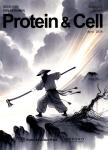The hierarchy quorum sensing networ in Pseudomonas aeruginosa
The hierarchy quorum sensing networ in Pseudomonas aeruginosa作者机构:Institute of Molecular and Cell Biology Agency for Science Technology and Research Singapore Singapore Guangdong Province Key Laborato-ry of Microbial Signals and Disease Control College of Natural Resources and Environmental Sciences South China Agricultural University Guangzhou 510642 China
出 版 物:《Protein & Cell》 (蛋白质与细胞(英文版))
年 卷 期:2015年第6卷第1期
页 面:26-41页
核心收录:
学科分类:090603[农学-临床兽医学] 12[管理学] 1201[管理学-管理科学与工程(可授管理学、工学学位)] 081104[工学-模式识别与智能系统] 08[工学] 09[农学] 0906[农学-兽医学] 0835[工学-软件工程] 0811[工学-控制科学与工程] 0812[工学-计算机科学与技术(可授工学、理学学位)]
基 金:This work was funded by the Biomedical Research Council Agency for Science Technology and Research (A'STAR) Singapore and by the National Natural Science Foundation of China (Grant No. 31330002). We apologize to the scientists who made contributionsto the field but their works have not been cited due to space limitations
主 题:quorum sensing IQS PQS las rhl,Pseudomonas aeruginosa virulence environmental factors
摘 要:Pseudomonas aeruginosa causes severe and persistent infections in immune compromised individuals and cystic fibrosis sufferers. The infection is hard to eradi- cate as P. aeruginosa has developed strong resistance to most conventional antibiotics. The problem is further compounded by the ability of the pathogen to form biofilm matrix, which provides bacterial cells a protected environment withstanding various stresses including antibiotics. Quorum sensing (QS), a cell density-based intercellular communication system, which plays a key role in regulation of the bacterial virulence and biofilm formation, could be a promising target for developing new strategies against P. aeruginosa infection. The QS network of P. aeruginosa is organized in a multi-layered hierarchy consisting of at least four interconnected signaling mechanisms. Evidence is accumulating that the QS regulatory network not only responds to bacte- rial population changes but also could react to envi- ronmental stress cues. This plasticity should be taken into consideration during exploration and development of anti-QS therapeutics.



